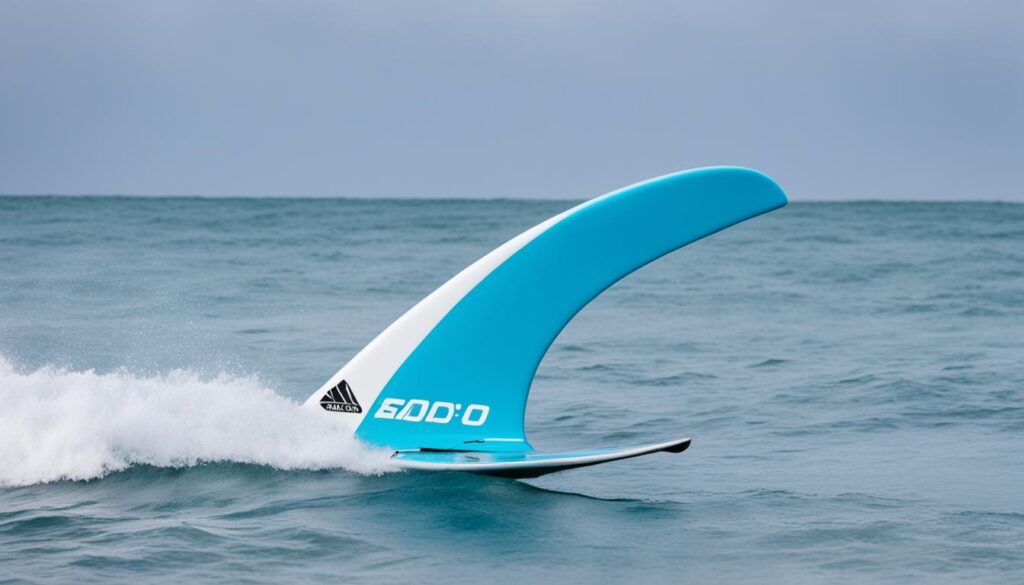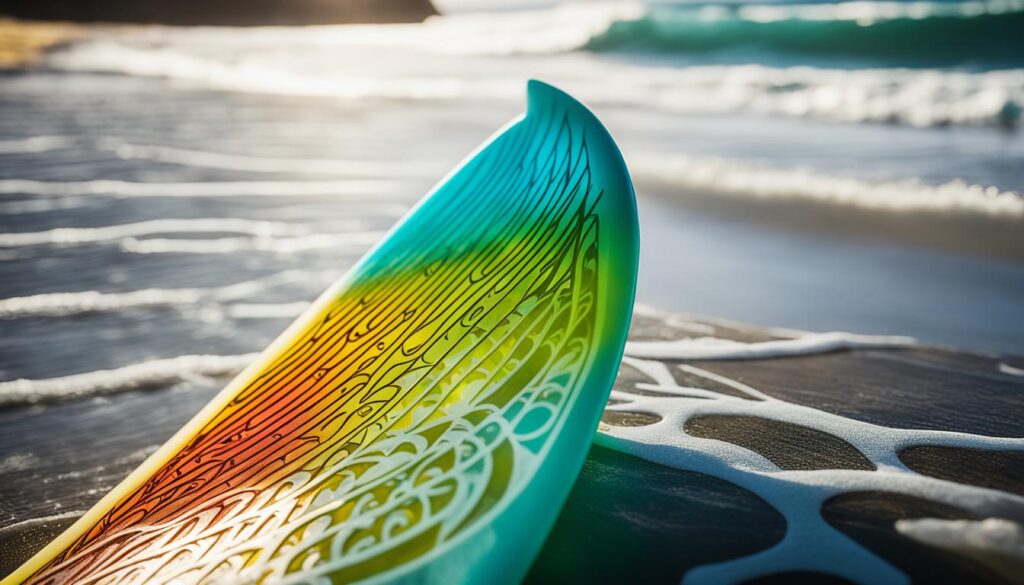Are you ready to take your surfing game to the next level? It’s time to dive into the world of surfboard fins and unlock the secrets to maximizing your performance on the waves. Whether you’re a beginner looking for the best fins to start your journey or an experienced surfer in search of the ultimate setup, this comprehensive guide has got you covered.
From choosing the right size and configuration to understanding the crucial elements that make up a surfboard fin, we’ll walk you through everything you need to know to make an informed decision. Discover the top surfboard fin brands, learn valuable tips for selecting the perfect fins, and explore custom options for a personalized surfing experience. Get ready to ride the waves like never before!
Key Takeaways:
- Learn how to choose the best surfboard fins based on your riding style and wave conditions.
- Explore the differences between glassed-in and removable fins and their pros and cons.
- Understand the impact of fin size and configuration on speed, maneuverability, and responsiveness.
- Discover the essential elements of surfboard fins and how they affect performance and control.
- Get expert tips for selecting the right fins that align with your ability and quality expectations.
Types of Surfboard Fins: Glassed-In or Swappable (Removable) Fins
When it comes to surfboard fins, there are two main types: glassed-in fins and removable fins. Each type offers different benefits and considerations for surfers.
Glassed-In Fins
Glassed-in fins are an integral part of the surfboard, laminated into the board during its construction. These fins provide a smooth and solid feel, as they are firmly attached to the board. The seamless integration of glassed-in fins enhances the performance and stability of the surfboard.
However, one drawback of glassed-in fins is that they are more challenging to repair. If a glassed-in fin gets damaged or broken, it requires professional repair work, which can be costly and time-consuming. The inability to remove and replace glassed-in fins limits flexibility in adapting to different wave conditions or experimenting with different fin setups.
Swappable (Removable) Fins
Removable fins, on the other hand, provide surfers with increased versatility and convenience. These fins are designed to be fitted into a fin box, which is installed and glassed over on the surfboard. This system allows for easy installation, removal, and replacement of fins using a fin key, without the need for professional assistance.
The main advantage of removable fins is the ability to adapt to various wave conditions and riding styles. Surfers can experiment with different fin setups, adjusting the number, size, and configuration of fins, depending on the waves they are riding or the desired performance characteristics. It opens up a world of possibilities for customization and optimizing the surfboard’s performance.
There are major brands that offer removable fins with their respective fin systems. The two most popular brands are:
- FCS fin system: FCS (Fins Control System) is a widely recognized and trusted brand in the surfing industry. Their fin system offers a variety of fin boxes and compatible fins suitable for different surfboard shapes and styles.
- Futures fin system: Futures is another renowned brand known for its removable fin system. They provide high-quality fin boxes and fins designed to maximize performance and responsiveness.
Both FCS and Futures offer a range of options for surfers to choose from, ensuring compatibility with their surfboards and personal preferences.
Now that we have explored the different types of surfboard fins, it’s time to dive deeper into the factors to consider when choosing the right fins. In the next section, we will discuss the importance of fin size and fin configuration.
Choosing the Right Surfboard Fins: Size and Fin Configuration
When it comes to selecting surfboard fins, two key factors to consider are the size and fin configuration. These aspects play a significant role in determining your surfing performance and the overall feel of your board.
Surfboard Fin Size
The size of the fins should be carefully chosen based on your weight. Different fin sizes are recommended for varying weight ranges to ensure optimal performance and control on the waves. Below is a general guideline for choosing the right surfboard fin size:
- Lightweight surfers (less than 150 lbs): Small to medium fins
- Medium-weight surfers (150-180 lbs): Medium fins
- Heavyweight surfers (180+ lbs): Large to extra-large fins
Remember, these recommendations are a starting point, and personal preferences may also come into play. It’s best to try different sizes and see which one suits your surfing style and wave conditions the best.
Fin Configuration
The fin configuration refers to the number and placement of fins on your surfboard. Each configuration offers distinct advantages and is suitable for different riding styles and wave conditions. Here are some common fin configurations:
- Single Fin: Consisting of a single center fin, this configuration offers stability and pivot-style turning. It is commonly found in longboards and retro-style boards.
- Twin Fin: Featuring two fins positioned close to the tail, twin fins provide speed, maneuverability, and a looser feel. This configuration is popular for fast and playful surfing.
- Thruster Fin: The thruster configuration is the most widely used and consists of three fins: a center fin and two smaller side fins. This setup offers a balance of speed, control, and maneuverability, making it versatile for various wave conditions.
- Quad Fin: Quad fins have four fins, typically two larger side fins and two smaller rear fins. This configuration offers exceptional speed, drive, and control, making it ideal for down-the-line surfing and generating power on small waves.
- 5-Fin System: The 5-fin system provides maximum versatility by allowing surfers to use their board with either a thruster configuration or a quad configuration. It combines the control and maneuverability of a thruster with the speed and drive of a quad.
- 2+1 Fin: This configuration is commonly found in longboards and combines a single center fin with two smaller side fins. It offers stability, control, and the ability to perform tighter turns compared to a single fin.
Choosing the right fin configuration depends on factors such as wave type, your surfing style, and personal preference. Experimenting with various configurations can help you discover the setup that enhances your performance on the waves.
Now that you understand the importance of surfboard fin size and configuration, you can make an informed decision that aligns with your weight, riding style, and wave conditions. The next section will delve into the essential elements of surfboard fins, providing further insights to enhance your surfing experience.
Understanding the Elements of Surfboard Fins: Sweep, Toe, Base Length, Foil, Flex, Height, and Cant
Understanding the various elements of surfboard fins is crucial in selecting the right fins for your board. Each element plays a significant role in the performance and feel of your surfboard, allowing you to maximize your surfing experience.
Fin Sweep: Also known as the fin rake, the sweep refers to the arc or curve of the fin’s front edge. It directly influences the turning ability of the surfboard. Fins with a greater sweep provide a longer turning arc, ideal for larger waves and drawn-out turns. On the other hand, fins with lesser sweep offer quicker and sharper turns, suitable for smaller waves and more aggressive maneuvers.
Fin Toe: The toe, also referred to as splay, pertains to the angle at which the side fins are positioned in relation to the center fin. This angle greatly influences the responsiveness and maneuverability of the surfboard. Fins with more toe angle deliver increased responsiveness, allowing for tighter turns, while fins with less toe angle provide greater stability and control, ideal for generating speed.
Fin Base Length: The base length of a fin is the distance between the trailing edge of the base and the leading edge of the fin’s tip. It impacts both the speed and maneuverability of the surfboard. Longer base lengths provide more drive and speed, making them suitable for powerful and hollow waves. Conversely, shorter base lengths offer increased maneuverability and quicker direction changes, perfect for smaller and less powerful waves.
Fin Foil: The fin foil refers to the shape of the fin’s inside and outside faces. It plays a vital role in determining the fin’s performance, control, and lift. Fins with a thin and symmetrical foil provide equal performance in both directions, making them ideal for twin fins and asymmetric boards. Fins with a thicker and asymmetrical foil offer enhanced lift and control, suitable for high-performance surfing and generating speed.
Fin Flex: The flexibility of a fin determines its responsiveness and ability to store and release energy during turns. Stiffer fins offer more control and stability, providing better drive and speed through turns. On the other hand, more flexible fins provide a lively and responsive feel, allowing for tighter and more dynamic turns. The ideal fin flex depends on personal preference, wave conditions, and surfing style.
Fin Height: The fin height refers to the distance between the base and the highest point of the fin. It influences both the stability and maneuverability of the surfboard. Taller fins offer increased stability and control, making them suitable for larger waves. Shorter fins provide greater maneuverability, allowing for quick direction changes and tighter turns in smaller waves.
Fin Cant: The fin cant is the angle at which the fin is positioned in relation to the surfboard. It affects the amount of grip a fin provides during turns. Fins with more cant angle deliver enhanced maneuverability and responsiveness, as they engage the water more aggressively. Fins with less cant angle offer increased stability and control, providing a smoother and more controlled ride.
By understanding and considering these elements, you can make informed decisions when selecting surfboard fins that suit your desired wave-riding style, wave conditions, and personal preferences.

| Fin Element | Description |
|---|---|
| Fin Sweep (Rake) | Arc or curve of the fin’s front edge that affects turning ability. |
| Fin Toe (Splay) | Angle at which side fins are positioned in relation to the center fin, influencing responsiveness. |
| Fin Base Length | Distance between the trailing edge of the base and the leading edge of the fin’s tip, impacting speed and maneuverability. |
| Fin Foil | Shape of the fin’s inside and outside faces, affecting performance and control. |
| Fin Flex | Flexibility of the fin, contributing to responsiveness and energy release during turns. |
| Fin Height | Distance between the base and the highest point of the fin, influencing stability and maneuverability. |
| Fin Cant | Angle at which the fin is positioned in relation to the surfboard, impacting grip and control during turns. |
Tips for Choosing the Best Surfboard Fins: Consider Your Ability and Quality
When it comes to choosing surfboard fins, there are a few factors to consider that can greatly impact your surfing experience. One important aspect to assess is your own ability level. Beginners may want to start with basic plastic fins that typically come with their beginner boards. These fins provide stability and are forgiving, allowing beginners to build their skills and progress at their own pace. As you become more comfortable and confident in the water, you can start exploring higher-quality fins to enhance your performance.
For more experienced surfers, investing in higher-quality fins can make a significant difference in your overall ride. Carbon fiber fins, for example, are known for their superior performance and durability. They are lightweight yet strong, providing excellent control and responsiveness in the water. Additionally, pro surfers often have their own signature fin models that are designed to meet their specific demands. While these pro signature models can be a bit pricier, they offer the advantage of being fine-tuned to suit the needs of professionals and are often well worth the investment.
However, it’s important to align your fin choice with your ability level. Advanced fins may not necessarily be suitable for beginners or intermediate surfers. If you’re unsure about which fins to choose, it’s always a good idea to seek the advice of experts or experienced surfers who can provide valuable insights and recommendations based on your specific needs and skill level. By considering both your ability and the quality of the fins, you can make an informed decision that will enhance your surfing experience and take your skills to the next level.

